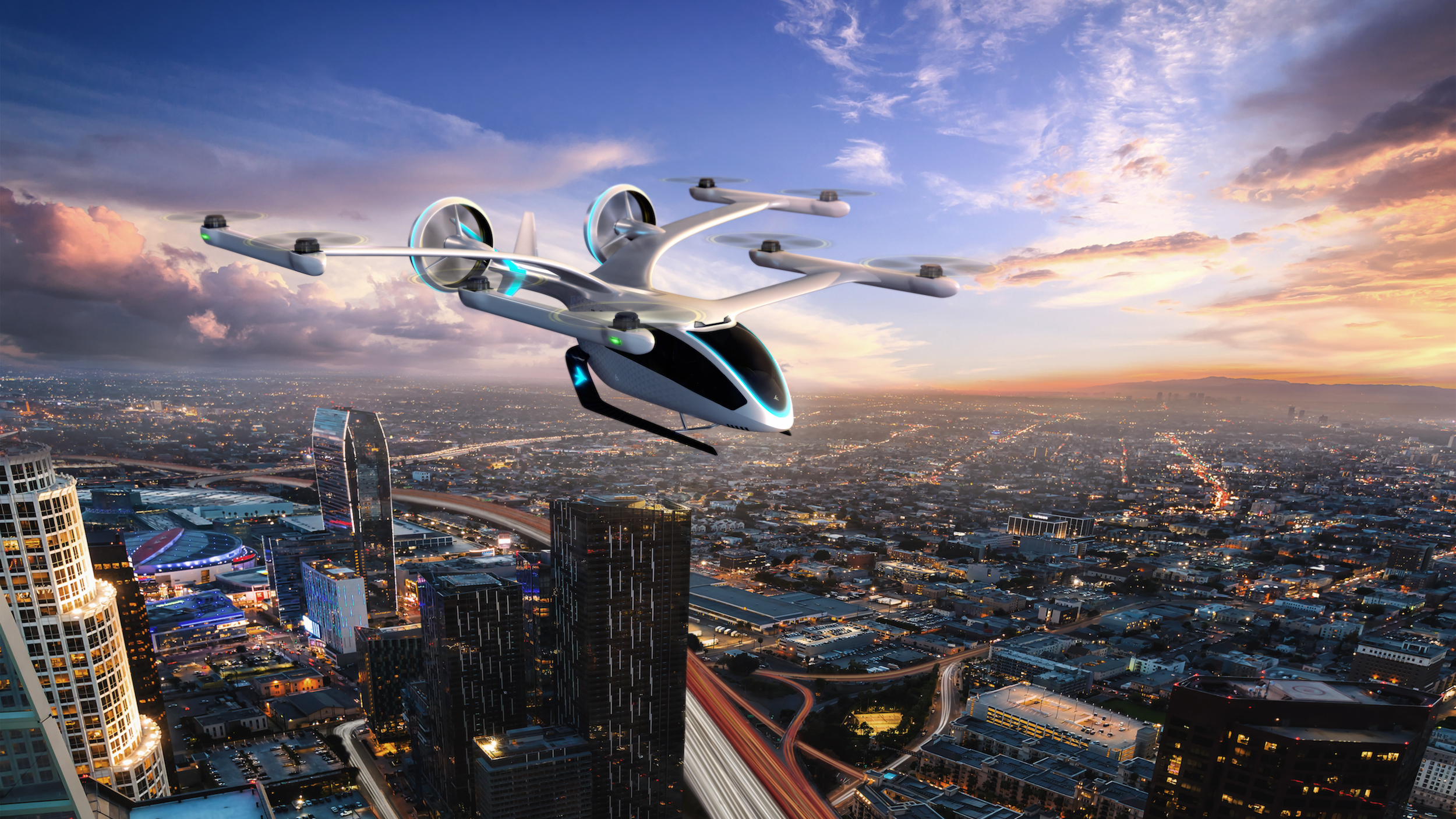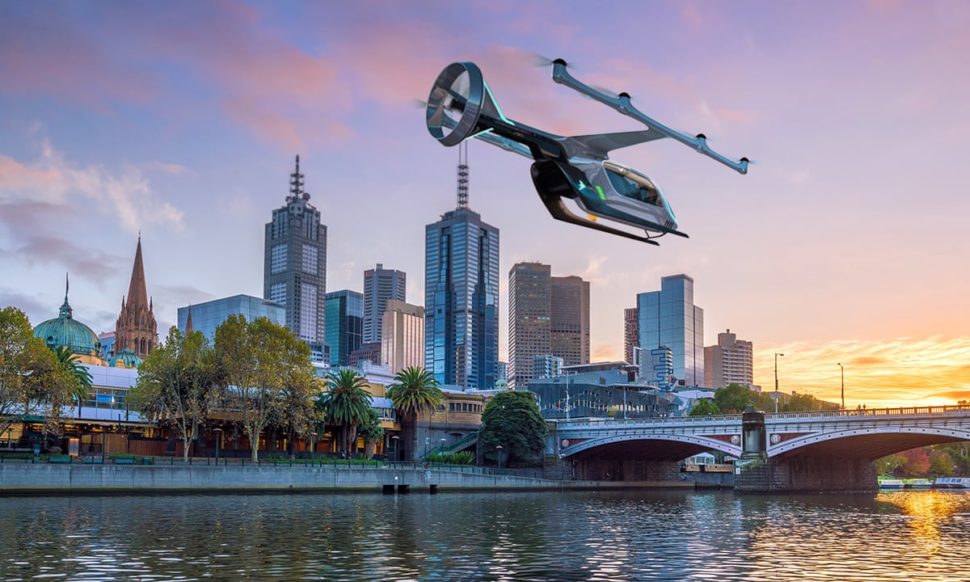Det er daglig nyheter om oppfinnsomme grupper som har vyer så det holder. Problemet for dem og deres investorer er at det ikke finnes regler. Det må etableres enlang rekke forskrifter og standarder før disse kan fly med betalende passasjerer. I stedet for å helle kaldt vann i blodet til disse, oppildnes det til videre utvikling, slik som Bente Heggedal Løvold fra Luftfartstilsynet gjør overfor NRK etter å ha fløyet i en slik. Slutt med det Heggelal Løvold og fortell meg heller hvor i terrenget sertifiseringsforskrifter befinner seg. (Red.)
Uber Elevate: Pick A Fantasy
Wait. What? These things aren’t flying cars. They just aren’t. Or are they?
This is the little argument I had with myself yesterday while covering the Uber Elevate Summit in Washington, D.C., via remote streaming. During his introduction, Nikhil Goel, Uber’s head of product for Elevate, referred to these new air taxis as flying cars. The first time he said it, I thought it was a slip of the tongue, but the revelation came the third time he used the same term.
What we have here is a divergent definition of what a car is. For those of us in aviation, a car is what you drive to the airport to fly an airplane. Driving and flying are disparate activities and for us, a flying car—say like the Terrafugia—are cars that fly or airplanes that drive. I think I’m on safe ground in saying that pilots are broadly skeptical of flying cars because none have proven commercially viable and they appear to be bad cars and marginal airplanes. That’s because even the cheapest cars do what they do well and the same is true of airplanes—if there were cheap airplanes, but that’s another rant.
So where does Goel get off calling these air taxis cars? Here’s how: To the Uberscenti, transportation is independent of means; it’s just moving people or things from A to B. EVTOLs are distinguishable from cars only in that they operate in the third dimension. They are merely service volume extenders. In autonomous eVTOL ecosystem of the future, transportation will be blind to the type of vehicle. Uber’s view is that data-driven dynamic pricing and efficiency will level everything.
Will it? Impossible to say at this juncture, but the argument is compelling. It will depend on demand density and a robust ground infrastructure. This is probably the bigger challenge than the flying vehicles themselves.
And speaking of the eVTOL vehicles, aerospace veterans may look at what Uber and its partner companies are doing and think these guys are clueless about the regulatory hurdles they face. Actually, I’d say the reverse is true. The conference spent quite some time considering the regulatory burden and how they might overcome it. They presented all the right talking heads saying all the right things. The awareness is there. The hard (and expensive) part will be the fine detail of actually certifying eVTOLs, not just listening to the FAA saying it’s sympathetic and trade associations cheering the agency’s new-found largesse.
Match These Numbers
A splash of cold reality came from Dan Elwell, acting FAA administrator. In a talk I’d call unusually frank for an administrator—acting or not—he let these numbers just sort of land on the stage with a thud: One fatality in 90 million flights. That’s the safety record U.S. airlines have achieved for most of the last decade.
And it is stunning. It’s a safety level of about 10-8 and it has been achieved through regulation, technology and pervasive analysis of safety-related data. By comparison, GA lives at 10-5, which is roughly a fatality per 100,000 hours. (Apples and oranges warning there, I’m conflating hours and flights, but you get the idea. When measuring with a crayon and cutting with an axe, it matters little.)
This is where I see a potential disconnect in air-taxi safety expectations. Uber expects its air vehicles to be certified under Part 23 and flown under Part 135, both regulations that are less stringent than the Part 25/Part 121 that have delivered a functionally zero airline fatality rate. Fair or not, urban air mobility will probably be judged by the same standard and the flying public that will use these aircraft won’t understand that a few accidents—maybe more than a few—will be the price to pay on the long march to an accident-free UAM industry.
While Uber and the companies developing these aircraft understand this—or seem to—I’m skeptical of any claim that they’ll get there out of the box. There are too many variables and too many unknowns; %$#& will happen. They do have some out-of-the-blocks advantages. The systems to collect and analyze operational data aren’t just in place, they form the very bedrock of what will become UAM. The FAA and airline industry had to learn that over decades and the price was paid in blood. Second, these vehicles don’t have automation slapped on as an afterthought—737 MAX, I’m looking at you—but baked into their basic DNA. Once the bugs are chased out, that’s a plus, in my view.
And The Award Goes To…
For coverage of dreamy artists’ conceptions, slick videos of aircraft that haven’t flown yet and futuristic ramblings about the brave new world of urban mobility, the award goes to … us.
Yes, in a blinding moment of self-awareness, I’ll concede we are reporting on things that don’t exist and might not for a while. But there’s a reason and here it is: I don’t know if this UAM idea is going to gel, either by Uber or anyone else. I have doubts about it.
But however they are put to use, the aircraft are coming. Distributed electric propulsion will make evolutionary, if not revolutionary, changes in the way we fly and this is right in the general aviation wheelhouse. You’re watching history about to be made and that’s why AVweb is all over it.
Electric Aircraft: Battery Life Just As Important As Capacity
Battery limitations continue to stunt the potential of electric aircraft, but Uber is betting that current technology is good enough to make urban air mobility workable now and will only improve as the vehicles mature.
At this week’s Uber Elevate Summit in Washington, D.C., the company’s Mark Moore said battery capacity and longevity drives both the design of the aircraft and how they’ll be flown when UAM goes operational. “Everything points back to the batteries. We’ve got a very severe energy constraint, so you’ve got to design the entire aircraft around the battery if it’s going to work well,” Moore said. Moore spent years at NASA as electric vehicle expert and joined Uber Elevate as the company’s vehicle director of engineering.
Although Uber is relying on five companies to develop potential UAM aircraft, it’s intimately involved in evaluating and testing battery technology, including which chemistries work best and how to charge and maintain batteries. As the wider electric aircraft industry looks at applications for these aircraft, many companies are considering hybrid drive designs to extend range. For now, Uber is sticking with pure electrics.
That means that UAM aircraft have to accommodate the inevitable in-service degradation of batteries and factor those costs into the operating economics. “You have to design the aircraft for the end of life of the battery, not a new battery,” Moore said.
In fact, battery longevity may be just as economically important as the aircraft’s basic range limits. As a result, Uber is developing charging and maintenance strategies aimed at extending battery life. Moore said vehicle range is less important than stage lengths, which are estimated to be typically about 25 miles.
“With these batteries, you have to be able to recharge to keep these vehicles productive on the network,” Moore said. So the typical trip that might best extend battery life is 25 miles, followed by a seven-minute charging period, followed by another short charging period.
“One of the key things to look at is state of charge. We’re not necessarily looking to charge to 100% and we don’t want to take them to zero,” said Celina Mikolajczak, who oversees Uber’s energy storage systems.
Under some duty/charging cycles Uber has simulated, she said, the packs would have to be changed every three months. But a short duty cycle followed by a short charge cycle might extend that to a year. “That starts to look a lot better,” she added.
Because of both range and battery life limitations, commercial electric aircraft will live in a narrow sweet spot that will depend, in part, on flight hour costs. Moore offered a glimpse. Against the Bell 407 GXi that might be used in the just-announced UberCopter service from Manhattan to JFK airport, operating costs for the electric vehicle are estimated to be $700 compared to $1192 for the helicopter.





Ingen kommentarer:
Legg inn en kommentar
Merk: Bare medlemmer av denne bloggen kan legge inn en kommentar.